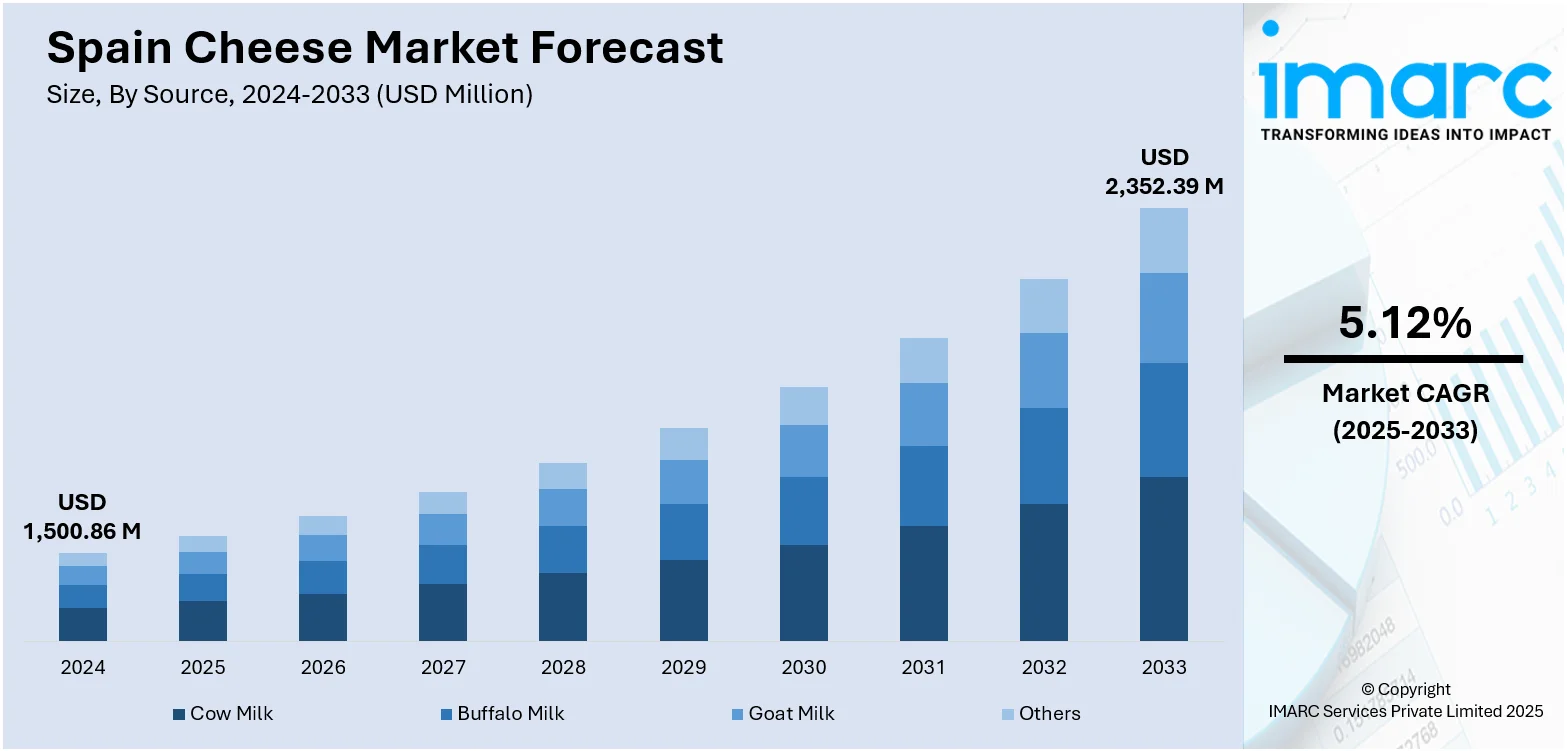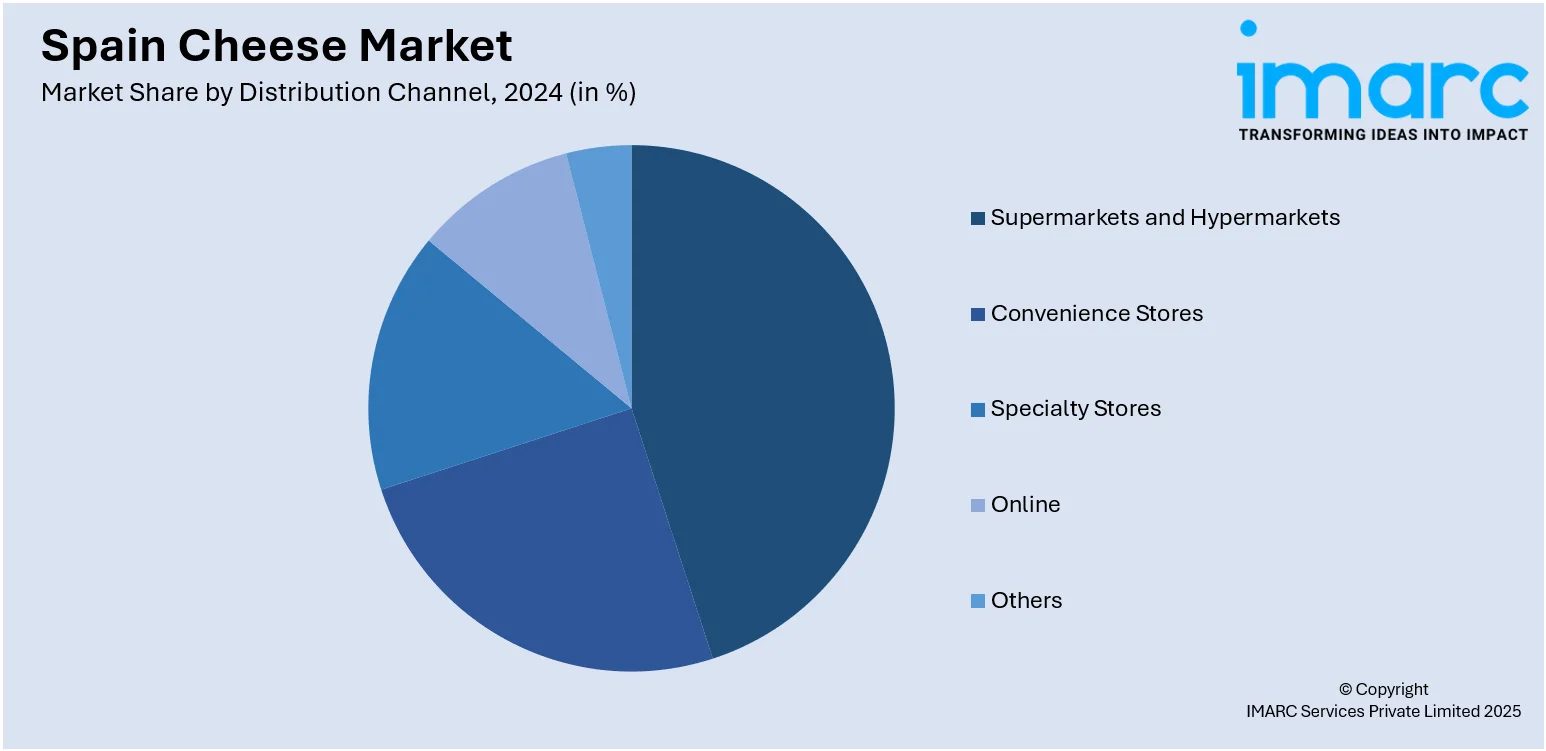
Spain Cheese Market Size, Share, Trends and Forecast by Source, Type, Product, Format, Distribution Channel, and Region, 2025-2033
Spain Cheese Market Overview:
The Spain cheese market size reached USD 1,500.86 Million in 2024. The market is projected to reach USD 2,352.39 Million by 2033, exhibiting a growth rate (CAGR) of 5.12% during 2025-2033. The market is driven by expanding demand for artisanal versions, functionally healthy products, and convenient snacking formats. Shifting consumer lifestyles, heightening health awareness, and a strong interest in regional culinary heritage are creating purchasing patterns. Retailers are reacting with expanded assortments and focused innovations. In addition, growing tourism and gastronomic awareness keep reinforcing cheese's cultural importance. These drivers combined support protracted domestic and export momentum, enhancing the competitive standing and increasing Spain cheese market share in several channels.
|
Report Attribute
|
Key Statistics
|
|---|---|
|
Base Year
|
2024
|
|
Forecast Years
|
2025-2033
|
|
Historical Years
|
2019-2024
|
| Market Size in 2024 | USD 1,500.86 Million |
| Market Forecast in 2033 | USD 2,352.39 Million |
| Market Growth Rate 2025-2033 | 5.12% |
Spain Cheese Market Trends:
Emergence of Artisanal and PDO Types of Cheese
One key trend in the Spain cheese market is consumer demand for artisanal and Protected Designation of Origin (PDO) types of cheese. This trend reflects a burgeoning interest in local heritage, authenticity, and traditional production practices. Spanish consumers are increasingly choosing regional varieties like Manchego, Mahón-Menorca, and Idiazábal, which are known for their distinct flavor profile and small-batch artisanal craftsmanship. The cultural ownership of products is also supported by the tourism and gastronomy industries placing importance on cheese pairing with regional wines and foods. Therefore, supermarkets and specialty food stores are increasing their offerings with more premium, small-batch versions. According to the reports, in 2023, Spanish PDO cheeses featured prominently in exports to the United States, with Spain shipping over 8,700 tonnes of cheese valued at more than €105 million—including PDO varieties like Manchego and Idiazábal—representing approximately 13 % of total export value, as reported by InLac and European Union promotional efforts. Moreover, growth in the Spanish cheese market is by these changing preferences, as artisan cheese is emerging as a major differentiator in domestic as well as export markets. This reflects how food quality, origin labeling, and cuisine identity are influencing Spain cheese market trends.

To get more information on this market, Request Sample
Growing Demand for Health-Focused and Functional Cheeses
Nutrition and health have become imperative factors for consumers, leading to a significant increase in demand for healthy, functional cheese products throughout Spain. These include low-fat, lactose-free, high-protein, and fortified cheeses intended to accommodate dietary objectives and healthful lifestyles. This adjustment is partly a result of heightened awareness of food intolerance rising health concerns, and the general effect of Mediterranean eating principles. With consumers demanding balance between indulgence and nutrition, cheese makers are responding with products that preserve traditional taste and texture while being nutritionally sound. Retailers are promoting these health-oriented variants through labeling tactics and segmentation of the shelf. In addition, urban lifestyles and busy lives are driving demand for portion-controlled, convenient-to-eat cheese snacks. These trends, therefore, highlight the diversification of market trends, whereby the category evolves from both taste and health considerations and drives Spain cheese market growth by means of product differentiation.
Growth of Cheese in Snacking and Convenience Formats
The rising use of cheese in snacking and convenience-driven consumption is revolutionizing the conventional perception of cheese in Spain. Although traditionally linked to meals and sit-down eating episodes, cheese is increasingly becoming accepted as a convenient, on-the-go snack food. Packaging innovations, including resealable packages, single-serve packaging, and pre-cut mixes, have made this possible. These formats appeal particularly to working professionals, active households, and school-aged children who need fast but healthy alternatives. New product development is frequently accompanied by combinations with nuts, dried fruits, or crackers, which introduce diversity and improve customer attractiveness. The trend also aligns with the overall premiumization movement, given that customers are ready to pay more for premium quality, easy-to-eat snacks. Shifting consumption patterns and an amplified focus on convenient eating habits make this transformation heavily conducive to Spanish cheese market development. Usage occasion diversification is a manifestation of changing Spain cheese market trends that are consistent with contemporary lifestyles and dietary versatility.
Spain Cheese Market Segmentation:
IMARC Group provides an analysis of the key trends in each segment of the market, along with forecasts at the country and regional levels for 2025-2033. Our report has categorized the market based on source, type, product, format, and distribution channel.
Source Insights:
- Cow Milk
- Buffalo Milk
- Goat Milk
- Others
The report has provided a detailed breakup and analysis of the market based on the source. This includes cow milk, buffalo milk, goat milk, and others.
Type Insights:
- Natural
- Processed
A detailed breakup and analysis of the market based on the type have also been provided in the report. This includes natural and processed.
Product Insights:
- Mozzarella
- Cheddar
- Feta
- Parmesan
- Roquefort
- Others
The report has provided a detailed breakup and analysis of the market based on the product. This includes mozzarella, cheddar, feta, parmesan, roquefort, and others.
Format Insights:
- Slices
- Diced/Cubes
- Shredded
- Blocks
- Spreads
- Liquid
- Others
A detailed breakup and analysis of the market based on the format have also been provided in the report. This includes slices, diced/cubes, shredded, blocks, spreads, liquid, and others.
Distribution Channel Insights:

- Supermarkets and Hypermarkets
- Convenience Stores
- Specialty Stores
- Online
- Others
The report has provided a detailed breakup and analysis of the market based on the distribution channel. This includes supermarkets and hypermarkets, convenience stores, specialty stores, online, and others.
Regional Insights:
- Northern Spain
- Eastern Spain
- Southern Spain
- Central Spain
The report has also provided a comprehensive analysis of all the major regional markets, which include Northern Spain, Eastern Spain, Southern Spain, and Central Spain.
Competitive Landscape:
The market research report has also provided a comprehensive analysis of the competitive landscape. Competitive analysis such as market structure, key player positioning, top winning strategies, competitive dashboard, and company evaluation quadrant has been covered in the report. Also, detailed profiles of all major companies have been provided.
Spain Cheese Market News:
- In June 2025, Lactalis launched El Ventero+Protein, a new cheese with 14g of natural milk protein for every 100g, 0% fat, and supplementary Vitamin D to promote calcium and phosphorus absorption. Manufactured from animal welfare milk, the launch responds to growing consumer desire for healthy, protein-enriched dairy products in Spain.
- In April 2024, Villarejo Añejo Curado en Miel y Orégano gained Champion Gold at the first Cheese from Spain Awards, held by ICEX/FWS at Salón Gourmets. This sheep's milk cheese is made by artisans and will be featured in international promotional activities to promote the quality and export value of Spanish cheese around the world.
Spain Cheese Market Report Coverage:
| Report Features | Details |
|---|---|
| Base Year of the Analysis | 2024 |
| Historical Period | 2019-2024 |
| Forecast Period | 2025-2033 |
| Units | Million USD |
| Scope of the Report |
Exploration of Historical Trends and Market Outlook, Industry Catalysts and Challenges, Segment-Wise Historical and Future Market Assessment:
|
| Sources Covered | Cow Milk, Buffalo Milk, Goat Milk, Others |
| Types Covered | Natural, Processed |
| Products Covered | Mozzarella, Cheddar, Feta, Parmesan, Roquefort, Others |
| Formats Covered | Slices, Diced/Cubes, Shredded, Blocks, Spreads, Liquid, Others |
| Distribution Channels Covered | Supermarkets and Hypermarkets, Convenience Stores, Specialty Stores, Online, Others |
| Regions Covered | Northern Spain, Eastern Spain, Southern Spain, Central Spain |
| Customization Scope | 10% Free Customization |
| Post-Sale Analyst Support | 10-12 Weeks |
| Delivery Format | PDF and Excel through Email (We can also provide the editable version of the report in PPT/Word format on special request) |
Key Questions Answered in This Report:
- How has the Spain cheese market performed so far and how will it perform in the coming years?
- What is the breakup of the Spain cheese market on the basis of source?
- What is the breakup of the Spain cheese market on the basis of type?
- What is the breakup of the Spain cheese market on the basis of product?
- What is the breakup of the Spain cheese market on the basis of format?
- What is the breakup of the Spain cheese market on the basis of distribution channel?
- What is the breakup of the Spain cheese market on the basis of region?
- What are the various stages in the value chain of the Spain cheese market?
- What are the key driving factors and challenges in the Spain cheese market?
- What is the structure of the Spain cheese market and who are the key players?
- What is the degree of competition in the Spain cheese market?
Key Benefits for Stakeholders:
- IMARC’s industry report offers a comprehensive quantitative analysis of various market segments, historical and current market trends, market forecasts, and dynamics of the Spain cheese market from 2019-2033.
- The research report provides the latest information on the market drivers, challenges, and opportunities in the Spain cheese market.
- Porter's five forces analysis assist stakeholders in assessing the impact of new entrants, competitive rivalry, supplier power, buyer power, and the threat of substitution. It helps stakeholders to analyze the level of competition within the Spain cheese industry and its attractiveness.
- Competitive landscape allows stakeholders to understand their competitive environment and provides an insight into the current positions of key players in the market.
Need more help?
- Speak to our experienced analysts for insights on the current market scenarios.
- Include additional segments and countries to customize the report as per your requirement.
- Gain an unparalleled competitive advantage in your domain by understanding how to utilize the report and positively impacting your operations and revenue.
- For further assistance, please connect with our analysts.
 Request Customization
Request Customization
 Speak to an Analyst
Speak to an Analyst
 Request Brochure
Request Brochure
 Inquire Before Buying
Inquire Before Buying




.webp)




.webp)












